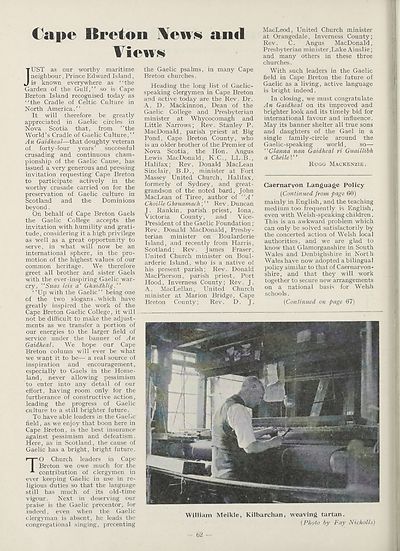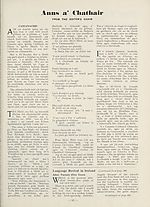An Comunn Gàidhealach Publications > Gaidheal > Volumes 44--45, January 1949--December 1950
(104) Page 62
Thumbnail gallery: Grid view | List view

Capo Itreton News ami
Views
JUST as our worthy maritime
neighbour. Prince Edward Island,
is known everywhere as ‘ ‘ the
Garden of the Gulf,” so is Cape
Breton Island recognised today as
‘‘the Cradle of Celtic Culture in
North America. ’ ’
It will therefore be greatly
appreciated in Gaelic circles in
Nova Scotia that, from ‘‘the
World’s Cradle of Gaelic Culture,”
An Gaidheal—that doughty veteran
of forty-four years’ successful
crusading and continuous cham¬
pionship of the Gaelic Cause, has
issued a very generous and pressing
invitation requesting Cape Breton
to participate actively in the
worthy crusade carried on for the
preservation of Gaelic culture in
Scotland and the Dominions
beyond.
On behalf of Cape Breton Gaels
the Gaelic College accepts the
invitation with humility and grati¬
tude , considering it a high privilege
as well as a great opportunity to
serve, in what will now be an
international sphere, in the pro¬
motion of the highest values of our
common heritage. We therefore
greet all brother and sister Gaels
with the ever-inspiring Gaelic war-
cry, "Suas leis a’ Ghaidhlig
‘‘Up with the Gaelic” being one
of the two slogans. which have
greatly inspired the work of the
Cape Breton Gaelic College, it will
not be difficult to make the adjust¬
ments as we transfer a portion of
our energies to the larger field of
service under the banner of An
Gaidheal. We hope our Cape
Breton column will ever be what
we want it to be:— a real source of
inspiration and encouragement,
especially to Gaels in the Home¬
land, never allowing pessimism
to enter into any detail of our
effort, having room only for the
furtherance of constructive action,
leading the progress of Gaelic
culture to a still brighter future.
To have able leaders in the Gaelic
field, as we enjoy that boon here in
Cape Breton, is the best insurance
against pessimism and defeatism.
Here, as in Scotland, the cause of
Gaelic has a bright, bright future.
TO Church leaders in Cape
Breton we owe much for the
contribution of clergymen in
ever keeping Gaelic in use in re¬
ligious duties so that the language
still has much of its old-time
vigour. Next in deserving our
praise is the Gaelic precentor, for
indeed, even when the Gaelic
clergyman is absent, he leads the
congregational singing, precenting
the Gaelic psalms, in many Cape
Breton churches.
Heading the long list of Gaelic¬
speaking clergymen in Cape Breton
and active today are the Rev. Dr.
A. D. Mackinnon, Dean of the
Gaelic College and Presbyterian
minister at Whycocomagh and
Little Narrows; Rev. Stanley P.
MacDonald, parish priest at Big
Pond, Cape Breton County, who
is an older brother of the Premier of
Nova Scotia, the Hon. Angus
Lewis MacDonald, K.C., LL.B.,
Halifax; Rev. Donald MacLean
Sinclair, B.D., minister at Fort
Massey United Church, Halifax,
formerly of Sydney, and great-
grandson of the noted bard, John
MacLean of Tiree, author of “A ’
Choille Ghruamach;'' Rev. Duncan
J. Rankin, parish priest, Iona,
Victoria County, and Vice-
President of the Gaelic Foundation ;
Rev. Donald MacDonald, Presby¬
terian minister on Boularderie
Island, and recently from Harris,
Scotland; Rev. James Fraser,
United Church minister on Boul¬
arderie Island, who is a native of
his present parish; Rev. Donald
MacPherson, parish priest, Port
Hood, Inverness County; Rev. J .
A. MacLellan, United Church
minister at Marion Bridge, Cape
Breton County; Rev. D. J.
MacLeod, United Church minister
at Orangedale, Inverness County;
Rev. C. Angus MacDonald,
Presbyterian minister,Lake Ainslie;
and many others in these three
churches.
With such leaders in the Gaelic
field in Cape Breton the future of
Gaelic as a living, active language
is bright indeed.
In closing, we must congratulate
An Gaidheal on its improved and
brighter look and its timely bid for
international favour and influence.
May its banner shelter all true sons
and daughters of the Gael in a
single family-circle around the
Gaelic-speaking world, so—
“Clanna nan Gaidheal ri Guaillibh
a CheileV’
Rugg Mackenzie.
Caernarvon Language Policy
(Continued from page 60)
mainly in English, and the teaching
medium too frequently is English,
even with Welsh-speaking children.
This is an awkward problem which
can only be solved satisfactorily by
the concerted action of Welsh local
authorities, and we are glad to
know that Glamorganshire in South
Wales and Denbighshire in North
Wales have now adopted a bilingual
policy similar to that of Caernarvon¬
shire, and that they will work
together to secure new arrangements
on a national basis for Welsh
schools.
(Continued on page 67)
William Meikle, Kilbarchan, weaving tartan.
(Photo by Fay Nicholls)
62 —
Views
JUST as our worthy maritime
neighbour. Prince Edward Island,
is known everywhere as ‘ ‘ the
Garden of the Gulf,” so is Cape
Breton Island recognised today as
‘‘the Cradle of Celtic Culture in
North America. ’ ’
It will therefore be greatly
appreciated in Gaelic circles in
Nova Scotia that, from ‘‘the
World’s Cradle of Gaelic Culture,”
An Gaidheal—that doughty veteran
of forty-four years’ successful
crusading and continuous cham¬
pionship of the Gaelic Cause, has
issued a very generous and pressing
invitation requesting Cape Breton
to participate actively in the
worthy crusade carried on for the
preservation of Gaelic culture in
Scotland and the Dominions
beyond.
On behalf of Cape Breton Gaels
the Gaelic College accepts the
invitation with humility and grati¬
tude , considering it a high privilege
as well as a great opportunity to
serve, in what will now be an
international sphere, in the pro¬
motion of the highest values of our
common heritage. We therefore
greet all brother and sister Gaels
with the ever-inspiring Gaelic war-
cry, "Suas leis a’ Ghaidhlig
‘‘Up with the Gaelic” being one
of the two slogans. which have
greatly inspired the work of the
Cape Breton Gaelic College, it will
not be difficult to make the adjust¬
ments as we transfer a portion of
our energies to the larger field of
service under the banner of An
Gaidheal. We hope our Cape
Breton column will ever be what
we want it to be:— a real source of
inspiration and encouragement,
especially to Gaels in the Home¬
land, never allowing pessimism
to enter into any detail of our
effort, having room only for the
furtherance of constructive action,
leading the progress of Gaelic
culture to a still brighter future.
To have able leaders in the Gaelic
field, as we enjoy that boon here in
Cape Breton, is the best insurance
against pessimism and defeatism.
Here, as in Scotland, the cause of
Gaelic has a bright, bright future.
TO Church leaders in Cape
Breton we owe much for the
contribution of clergymen in
ever keeping Gaelic in use in re¬
ligious duties so that the language
still has much of its old-time
vigour. Next in deserving our
praise is the Gaelic precentor, for
indeed, even when the Gaelic
clergyman is absent, he leads the
congregational singing, precenting
the Gaelic psalms, in many Cape
Breton churches.
Heading the long list of Gaelic¬
speaking clergymen in Cape Breton
and active today are the Rev. Dr.
A. D. Mackinnon, Dean of the
Gaelic College and Presbyterian
minister at Whycocomagh and
Little Narrows; Rev. Stanley P.
MacDonald, parish priest at Big
Pond, Cape Breton County, who
is an older brother of the Premier of
Nova Scotia, the Hon. Angus
Lewis MacDonald, K.C., LL.B.,
Halifax; Rev. Donald MacLean
Sinclair, B.D., minister at Fort
Massey United Church, Halifax,
formerly of Sydney, and great-
grandson of the noted bard, John
MacLean of Tiree, author of “A ’
Choille Ghruamach;'' Rev. Duncan
J. Rankin, parish priest, Iona,
Victoria County, and Vice-
President of the Gaelic Foundation ;
Rev. Donald MacDonald, Presby¬
terian minister on Boularderie
Island, and recently from Harris,
Scotland; Rev. James Fraser,
United Church minister on Boul¬
arderie Island, who is a native of
his present parish; Rev. Donald
MacPherson, parish priest, Port
Hood, Inverness County; Rev. J .
A. MacLellan, United Church
minister at Marion Bridge, Cape
Breton County; Rev. D. J.
MacLeod, United Church minister
at Orangedale, Inverness County;
Rev. C. Angus MacDonald,
Presbyterian minister,Lake Ainslie;
and many others in these three
churches.
With such leaders in the Gaelic
field in Cape Breton the future of
Gaelic as a living, active language
is bright indeed.
In closing, we must congratulate
An Gaidheal on its improved and
brighter look and its timely bid for
international favour and influence.
May its banner shelter all true sons
and daughters of the Gael in a
single family-circle around the
Gaelic-speaking world, so—
“Clanna nan Gaidheal ri Guaillibh
a CheileV’
Rugg Mackenzie.
Caernarvon Language Policy
(Continued from page 60)
mainly in English, and the teaching
medium too frequently is English,
even with Welsh-speaking children.
This is an awkward problem which
can only be solved satisfactorily by
the concerted action of Welsh local
authorities, and we are glad to
know that Glamorganshire in South
Wales and Denbighshire in North
Wales have now adopted a bilingual
policy similar to that of Caernarvon¬
shire, and that they will work
together to secure new arrangements
on a national basis for Welsh
schools.
(Continued on page 67)
William Meikle, Kilbarchan, weaving tartan.
(Photo by Fay Nicholls)
62 —
Set display mode to:
![]() Universal Viewer |
Universal Viewer | ![]() Mirador |
Large image | Transcription
Mirador |
Large image | Transcription
| An Comunn Gàidhealach > An Comunn Gàidhealach Publications > Gaidheal > Volumes 44--45, January 1949--December 1950 > (104) Page 62 |
|---|
| Permanent URL | https://digital.nls.uk/127123284 |
|---|
| Description | This contains items published by An Comunn, which are not specifically Mòd-related. It includes journals, annual reports and corporate documents, policy statements, educational resources and published plays and literature. It is arranged alphabetically by title. |
|---|
| Description | A collection of over 400 items published by An Comunn Gàidhealach, the organisation which promotes Gaelic language and culture and organises the Royal National Mòd. Dating from 1891 up to the present day, the collection includes journals and newspapers, annual reports, educational materials, national Mòd programmes, published Mòd literature and music. |
|---|---|
| Additional NLS resources: |
|

